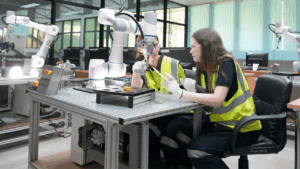With technology advancing at a rapid pace, start-ups are creating products that turn our everyday and industrial waste into something useful to the environment.
With the Cleantech industry in growth mode, we looked into some of these new advancements and how they can make an impact on climate change reduction and create a zero-waste economy.
Green Power House
Ever thought to yourself “there must be a way to turn residual biomass into eco-friendly agri-products while capturing carbon and growing organic food”? Neither had we, but after learning all that this new greenhouse-on-steroids can do we wished we’d thought of it first.
This futuristic pyramid-shaped greenhouse is turning fast-growing algae into organic fertilizer while sequestering and recycling CO2. The entire process is zero-waste, off-grid, and carbon-negative.
Is algae the answer to food security?
“They’re disrupting food, fuel and fertilizer all in one little power house … doing in 4-5 days to do what nature would take about 400 years” – The Need to GROW
Every element of the Green PowerHouse (GPH) is designed as part of a closed-loop system. So how does it work?
- The first part of the cycle uses a photobioreactor that harnesses sunlight to promote fast-growing algae (with the pyramid also doubling as a greenhouse for crop growth).
- Next, the algae are funnelled into an anaerobic bioreactor which creates a liquid organic fertilizer.
- Captured biofuels produced in this process are sent to an organic carbon engine, designed for biomass conversion.
- The organic carbon engine, known as ‘the dragon’ turns biomass waste into a number of products (including bio-oil) that can be converted to electricity. The ‘dragon’ generates enough biofuel to power the entire GPH and its systems, with enough remaining to provide enough energy for about 100 homes.
- The whole process produces around 2 tonnes of biochar per day. The biochar can be used for soil recovery and to sequester CO2.
- Any residual CO2 and heat are returned back to the bioreactor to grow more algae and continue the cycle.
Because the system reclaims water from the biomass as well as rainwater collected from the building itself, it also is water-neutral or even water-positive. – Coneybeare Cleantech
What’s next for the Green Power House technology in Canada?
The Green Power House can be set up on just 1/4 acre of land and creates enough energy to power about 100 homes, with the added bonus of being able to vertically grow about 1/2 acre of food within the structure. On just 2 acres, it could produce enough energy to power a small town.
“With the sheer amount of biomass available in Canada, there is a tremendous opportunity to have the Green Power House units as common as grain elevators were 100 years ago. They are relatively small but very powerful revenue producers with strong environmental outcomes.” – Grant Kelba
For more information on how to build a green power house and how green power house cost, take a look at the green power house documentary: The Need to Grow.





